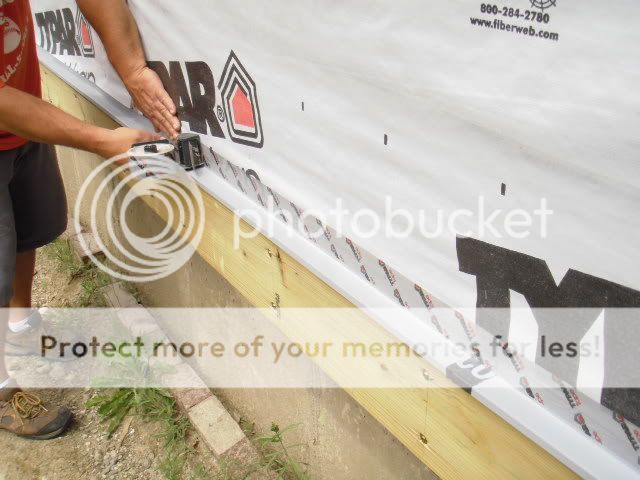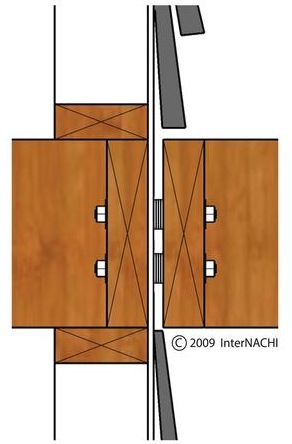Would you call out a missing flashing on a ledger board installed directly on to the vinyl siding? I think the answer is yes because water can penetrate behind the ledger through the penetrating lag bolts and potentially broken siding. Thoughts?
You answered you own question and I agree in calling it out. 
I was pretty sure that made sense. Thanks ![]()
I would also call out the ledger board applied over the vinyl siding. They installed it that way out of pure laziness to do it the right way. They assumed the vinyl would eliminate the need for the flashing. Or, they were just plain stupid. Flip a coin.
Ditto. Installation over the siding is a defect.
The proper way.


That can’t be proper… I only see it like that once or twice a year… ![]()
That’s the way I build them, but also has a WRB not shown. 
ditto…
I’ve heard that you can’t use alum flashing with the new treated wood.
You should not use Alluminum.
http://www.deckmagazine.com/article/188.html:)
You are corrrect but when was the deck built. Before the changed treated lumber it was fine. Copper can be used
The best details I have seen yet for deck-to-wall flashing is in the FEMA series for coastal construction… I would recommend it for anywhere.:
http://www.fema.gov/rebuild/mat/mat_fema499.shtm
Factsheet #5.2
Brian, here is the way deck ledgers and flashing is installed;
First a full SAF is installed on the exterior wall sheathing.
Then the ledger board is installed using GRK’s structural screws into the floor framing joist.
http://grkfasteners.com/en/RSS_1_2_information.htm
Then another strip of SAF is installed over the ledger.
Then the ledger flashing is installed over the top of the ledger, (this one is plastic, but copper is available).
Finally, the WRB is drapped down over the flashing and sealed with the products seal tape.
In some cases, the ledger board and band joist are intentionally kept separated by a stack of washers on the lag screw or bolts to allow water to run between the two boards. In other cases, there is insulation between the two boards. Even worse is when the siding or exterior finish system was not removed prior to the installation of the ledger board. Situations like this, where the ledger board and band joist are not in direct contact, significantly reduce the strength of the ledger connection to the structure and are not recommended by InterNACHI, unless the two members are sandwiching structural sheathing.
The image above depicts washers being used as spacers between the ledger board and band joist, which is incorrect.
Now, if you were a Member of Inachi, you would know that, wouldn’t you?;)
The FEMA method does not use washers as spacers but a wood spacer (preservative treated I would hope).
One item I would improve is the bottom Z-flashing #1- I would like to see a 1/4-1/2" gap between the horizontal section and the bottom of the ledger board for organic debris cleanout. This is a great detail for a deck installation where there is siding below the ledger board as in the above INACHI diagram. It is usually quite hard to get a good seal there, so get the drainage water out and away from the horizontal joint.
If you speak to the manufacturers about the WRB tape, they will tell you that it is only approved for use with their product.
As usual Brian you are the Master of all, but sometimes you don’t have a clue and blowing smoke.
This tape was used to keep the WRB from flapping in the wind and hold it down over the flashing.
I went back to this house from September of last year and hold and behold, the tape is still holding and been exposed to the weather all these months.
This is a photo of when I got to the job last week.
Are horizontal boards considered structural sheathing?
Depends what you call a horizontal board, in the case of the pictures it is a structural element part of the structural deck and secured to a structural frame that will support a minimum of #40 per square foot.
Now, is there anything else you would wish to teach me? After 45 years as a builder, I am always open to anything that will better myself.
Marcel -
This is a joke right. Thats NOT how we do decks in KC.
That kinda detail would be WAY to costly. Like Mr Warner already said, It must be wrong CAUSE we ain’t NEVER seen it that way (flashing / Bah humbug).
Houses and their water shedding elements are not to be designed to last for months, but for years!!
The building I looked at was 20 years old and had serious problems (called premature failure)…but, of course, you (with your 45 years of building) would know that red sheathing tape used to seal the WRB to the vinyl window nail flanges and pulling away from them thus allowing water entry is not a problem.
Do you have pictures of the window flashing/sealing/WRB installation details?
BTW…have you ever subscribed to The Journal Of Light Construction that started out in the 1980’s, I believe, as New England Builder? In 1992, they had techniques (from a book) on installing windows and doors to prevent water entry under the harshest of wind-driven rain conditions. The book was written by architects and covered different types of construction…it was 220 pages! Don’t think you can’t learn anything from books and magazines!!
The first problems of this new sort of water leakage that I was called to look at was in 1989…The gent that trained Joe Lstiburek about water leakage was brought in from Toronto to Halifax and I came in from New Brunswick. 5 days later we found the last of the water leaks that locals couldn’t find…It was upscale condos, a 7 story structure with brick veneer exterior. We had masons with hoses on swing staging to help determine water pathways so that all the brick veneer in certain areas would not have to be removed/replaced (up 5-6-7 stories!) to find the leaks. I was using my blower door which sucked 5,500 CFM…we found water moving 4 inches up over flashings…now how could that be??? Sometimes it took 2 or more hours for the water to find its way in! This was 2 years after the building was completed…we could see 30-40 other spots where the building owners had already removed brick to stop leaks.
The next one was an award winning design for an architect- built in 1989…rotting in 1994. The award should have been taken from him…he was not keeping up with current literature which, in 1985/6, said the rainscreen technique should be used in Atlantic Canada (and by location, the NE states also)
The most spectacular rain entry failure was more recent- 3.5 years ago…an $800,000 house had severe rot in 7 months…2 engineers, an energy auditor, a Phd mycologist, a warranty corp rep (warranty paid their $50,000 maximum) and myself were on site in a period of 2 weeks!! About 17 months after this investigation, a wildfire broke out in the area, destroying 6-7-8 upscale homes (NS folks will remember this). After the fires were put out, this house was investigated for arson…the fire had gone by this house, not even damaging the exterior while a house down the street was lost completely. A fire had been set in a bedroom of this new airtight house with HRV…but it went out as oxygen was used up…so the house did not burn down as desired by someone!!! In the end, no one was charged with arson!! I believe lawsuits are still ongoing between builder/warranty/others!!






